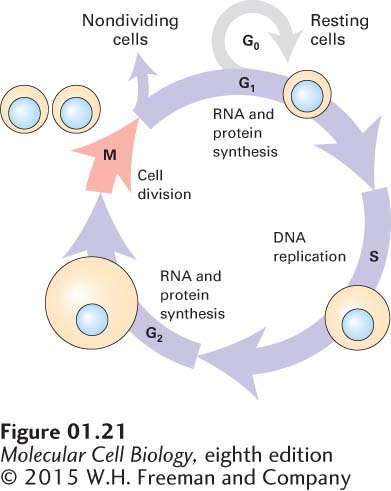All Eukaryotic Cells Use a Similar Cycle to Regulate Their Division
Unicellular eukaryotes, animals, and plants all use essentially the same cell cycle, the series of events that prepares a cell to divide, and the same actual division process, called mitosis. The eukaryotic cell cycle is commonly divided into four phases (Figure 1-21). The chromosomes and the DNA they carry are duplicated during the S (synthesis) phase. The replicated chromosomes separate during the M (mitotic) phase, in which the cell divides, and each daughter cell gets a copy of each chromosome. The M and S phases are separated by two gap phases, the G1 phase and the G2 phase, during which mRNAs, proteins, lipids, and other cell constituents are made and the cell increases in size.

FIGURE 1-21 During growth, all eukaryotic cells continually progress through the four phases of the cell cycle. In proliferating cells, the four phases of the cell cycle proceed successively. In humans, the cycle takes from 10 to 20 hours depending on cell type and developmental state. Yeasts divide much faster. During interphase, which consists of the G1, S, and G2 phases, the cell roughly doubles its mass. Replication of DNA during the S phase leaves the cell with four copies of each type of chromosome. In the mitotic (M) phase, the chromosomes are evenly partitioned into two daughter cells, and in most cases the cytoplasm divides roughly in half. Under certain conditions, such as starvation or when a tissue has reached its final size, cells will stop cycling and remain in a waiting state called G0. Some types of cells in G0 can reenter the cell cycle if conditions change.
Under optimal conditions, some bacteria, such as E. coli, can divide to form two daughter cells once every 30 minutes. Most eukaryotic cells take considerably longer to grow and divide, generally several hours. Moreover, the cell cycle in eukaryotes is normally highly regulated (see Chapter 19). This tight control prevents imbalanced, excessive growth of cells and tissues if essential nutrients or certain hormonal signals are lacking. Some highly specialized cells in adult animals, such as neurons and striated muscle cells, divide rarely, if at all. However, an organism usually replaces worn-out cells or makes more cells in response to a new need, as exemplified by the generation of new muscle cells from undifferentiated stem cells in response to exercise or damage. Another example is the formation of additional red blood cells when a person ascends to a higher altitude and needs more capacity to capture oxygen. The fundamental defect in cancer is loss of the ability to control the growth and division of cells. In Chapter 24 we examine the molecular and cellular events that lead to inappropriate, uncontrolled proliferation of cells.
